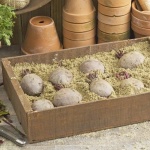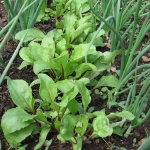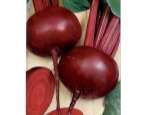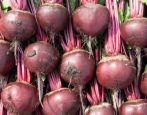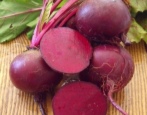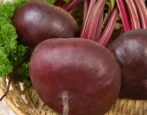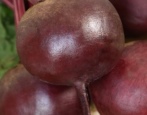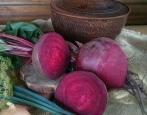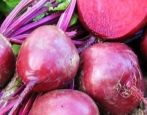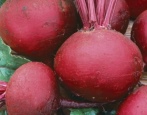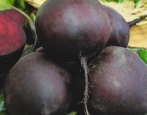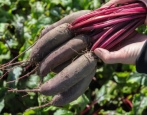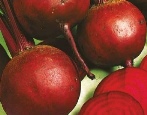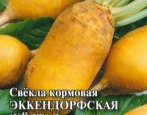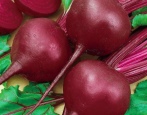
- Name synonyms: Pablo
- Year of approval: 1993
- Leaf rosette shape: upright
- Leaves: oval, green, slightly bubbly, medium waviness
- Petiole: medium length, pink-red
- The form: rounded
- Weight, g: 109-180
- Cork head: weak
- Pulp color : red
- Ringiness: rings are weak
The Pablo beet variety is quite well known in the Russian market, often included in the lists of the best as the most productive and reliable.
Description of the variety
Pablo's beetroot is a hybrid of Dutch production. Created by Bejo Zaden B. V. The hybrid variety was included in the Russian State Register in 1993.
Characteristics of the appearance of the plant and root crops
The rosette is vertical, with erect medium-sized leaves, 30-40 cm high. The leaf plate is oval, with slight blistering and waves along the edges. Petioles are of medium length, pink-red in color.
Root crops are rounded, almost perfectly spherical in shape, fruit height 8-10 cm, diameter 10-13 cm. Root crops are large, weighty, 109-180 grams each, with a potential of up to 500 grams (depending on the time of harvesting). The skin is smooth, thin. The pulp is dark red with a purple tinge, smooth, not prone to corking, the rings are barely noticeable.
Purpose and taste of tubers
Pablo's beets taste excellent. The pulp is tender, sugary, juicy. A versatile variety, used in fresh dishes, suitable for salads, borscht, desserts, well stored in winter, suitable for making caviar and freezing.
Maturation
The variety is medium early, harvesting is carried out 100-110 days after the emergence of mass shoots.
Yield
The yield is very stable, high, exceeds the Bordeaux standard 237. From 1 sq. m remove 6.5-7.5 kg of root crops, from 10 sq. m - 60-70 kg, from 1 hectare - on average 241-320 centners of fruit of commercial quality.
With good agricultural technology, it is possible to remove up to 520 centners per hectare - such results were obtained in the Kirov region. The yield of marketable fruits is quite high - 89-96%.
Growing regions
Pablo's beets are grown in all regions of the Russian Federation, from northern to southern. It grows well in the middle zone, in the Urals, in Eastern and Western Siberia, in the north, north-west and in the North Caucasus. The recommended growing regions do not include the Far East.
Growing and care
Like all varieties recommended for commercial production, the Pablo hybrid variety is very malleable and responsive to good care - demonstrating an even higher yield. The culture is good for newbies because it aims for good returns in all conditions. On average, it requires only standard care.
Seeds are prepared before planting: they are soaked two weeks before sowing, kept for 4 days, then refrigerated for 10 days.
The sowing site should be very sunny, and the soil warm - not less than + 8 ... 10 ° С
Pablo beet seed sowing pattern: 10 cm between plants, 30 cm between rows.
Beets must be thinned out, because from each seed, which is a seed, 2-3 sprouts appear. Thin three times: 1 week after germination, in the phase of the 4th true leaf. For the third time, thinning is combined with harvesting - at the beginning of August, you can collect all the smallest fruits, leaving 10 cm between the roots.
Beets like to loosen carefully - after each watering.
Timely removal of all weeds is important, no root crop likes competitors.
Watering must be done carefully. Excess moisture will make the fruit look watery. Usually watered only in dry months, on average, no more than 3-4 times per season. Watering is completely stopped 2-3 weeks before harvest.
Beets are usually not mulched, but if there is no time to monitor weeds and irrigation, the aisles can be covered with a thin layer of sawdust or peat - no more than 1-2 cm.
Top dressing in well-prepared soil is not necessary.But if initially the beets were planted in poor soil, they will accept fertilizers well.
Beets do not like a large amount of organic matter and nitrogen, it is better to minimize them. They are fed with nitrogen only until the first thinning. This can be a green infusion of nettle, diluted bird droppings, a solution of urea or ammonium nitrate.
From July, you can feed with potash fertilizers. Root crops intensively store nutrients. As a potash top dressing, wood ash is best suited - it simultaneously slightly reduces the acidity of the soil, disinfects the soil. Wood ash obtained from burning birch or pine also contains other trace elements such as phosphorus and boron. The latter beets are especially highly prized.
You can use potassium chloride, beets take it well. Boron top dressing is sometimes carried out separately: the leaves are sprayed with a solution of boric acid.
To increase the sweetness of the beets, it is watered with saline (1 tablespoon per 10 liters of water), sodium humate, but Pablo's beets gain sweetness well under any conditions.
As soon as the tops turn yellow, it's time to harvest the beets. But the Pablo variety can keep the foliage fresh for a very long time, so it is removed when the fruits are large enough. Harvested in late summer - early autumn, when the weather is right. It is best to choose a warm, sunny day.
For storage, beets are dried in the fresh air, cutting off the tops of 3-5 cm, then placed in wooden boxes, sprinkling each layer with barely wet sand, placed in a cellar or basement.

Beetroot tolerates cold snaps, therefore it is widely grown in the open field. When planting beets, you need to correctly determine the sowing time, choose a suitable place, prepare the beds, and do pre-sowing seed treatment.
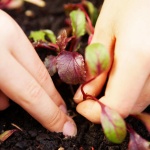
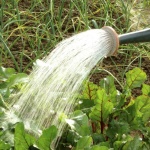
Soil requirements
The ideal option is nutritious loam or sandy loam rich in organic matter. On alumina dense soils or poor sandstones, beets will feel worse. The optimum acidity is 6.0-7.0 pH. More acidic soils lead to the fact that root crops suffer from rot, they turn out to be small and tasteless, more alkaline plants do not have enough nutrition.
In too acidic soils, 1 kg of dolomite flour is added per 1 sq. m.
A plot for beets is prepared in the fall: they are applied to sandy soils for 1 square meter. m 20 kg of clay flour, the same amount of peat and humus. Sand is poured into too dense soils - up to 40 kg per 1 sq. m.
Microelements are introduced: potassium sulfate (15 g), superphosphate (40 g), ammonium sulfate (30 g), boron (3 g). Dig up the area for 1 shovel bayonet. Ammonium nitrate is added during spring digging - 20 grams per 1 sq. m.
Fresh manure for beets can be applied only 1-2 years before planting.

Review overview
The Pablo variety is very popular with Russian gardeners. For many, the hybrid was a discovery and showed exactly what a good beet should be.The root vegetable can be chopped, but the pulp is still tasty. Inside the beets there are no rings, white veins, solid fibers, beets do not become oak under any growing conditions. The color of the pulp is bright, rich, maroon. The taste is pleasant. The consistency of beets is excellent - elastic, tender, juicy pulp is equally good in borscht, in vinaigrettes, in salads. The appearance of the beets is also pleasing: the fruits are even, chiseled, neat, one to one.
Many people call beets not large, but medium or small in size, but it is these dimensions that are most convenient in practice. A small root vegetable is best suited for cooking and storage, one or more root vegetables are enough for a fresh dish without residues.
The keeping quality of the variety for such a juicy smooth pulp and thin skin is excellent. Many gardeners noted that they did not have time to check the keeping quality of the variety until spring, because they ate everything much earlier.
The variety does not get sick at all, is resistant to cold, and tolerates drought well. Pablo's hybrid is valuable for all farms - from small to large. It also makes sense to consider for beginners.
